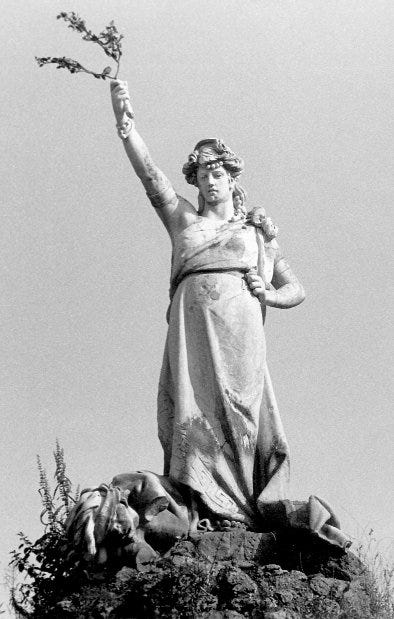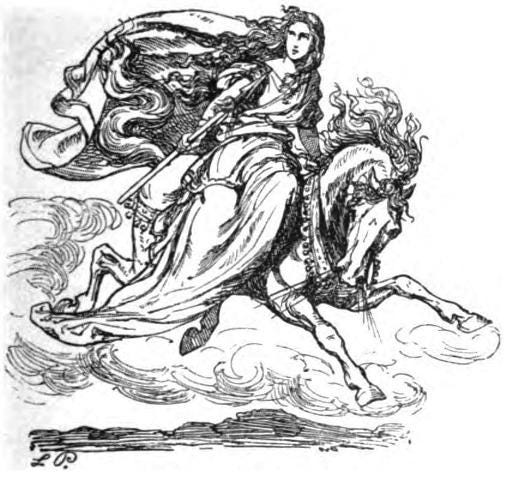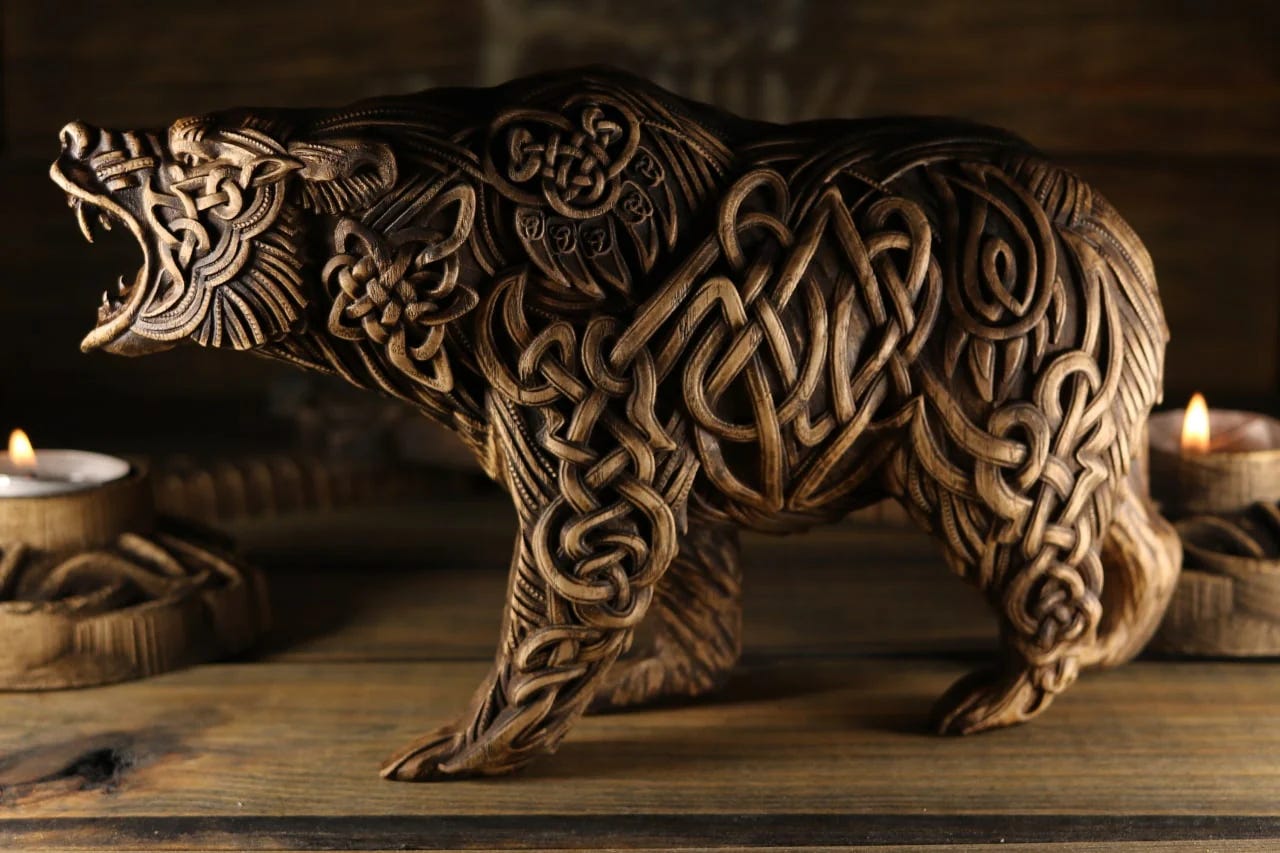The sovereignty goddess embodies a multifaceted array of roles and characteristics across various cultural traditions and mythologies. In her sacral function, she is associated with horses, symbolizing strength and freedom, while also overseeing the land, its people, and their prosperity. She weaves the threads of fate and destiny, shaping the lives of individuals and communities, reflecting a deep-seated belief in cosmic order. In her martial function, she serves as a guardian and advisor to warriors, guiding them through conflicts and transitions symbolized by crossroads and serpents. She is a complex archetype that encompasses a wide range of feminine qualities—nurturing, fierce, wise, protective, and powerful.
In Celtic mythology, such a Sovereignty goddess is often associated with water, nature, fertility and horses. The connection between the Sovereignty goddess, nature and water, represents her role as a bestower of life and fertility. She is often linked to bodies of water such as rivers, lakes, and springs, which are seen as sources of vitality and abundance. Epona is further also known as Potnia Theron, meaning lady of the animals. She and her horses, and dog also have been leaders of the souls in the after-life ride, with later literary parallels in Rhiannon, but also echoing the Wild Hunt. She also has associations with nightmares, as they thought of nightmares as being ridden as if on a wild horse. Where Epona was called upon to protect those who had nightmares, though she could also cause them. People may have invoked her name or sought her favor through rituals or prayers to ward off disturbing dreams or to find solace during times of fear or unrest.
When it comes to the Sovereignty Goddess Archetype within various Indo-European cultures. She and her priestesses further also played an important function in deciding when to start or end a war. Where as a fertility deity, she is revered as the mistress of animals, ensuring the prosperity of the land and the well-being of women in childbirth. Next to protecting the children and looking over them in the afterlife. Where her connection to water sources underscores her role in providing life and purification, while her mediation between the living and the deceased highlights her involvement in the cycle of life and death. Where through rituals and initiations like the Koryos and Arkteia, she facilitates bonding, community creation, and a connection with nature, tapping into primal and instinctual aspects of the human psyche. Some examples of the Sovereignty Goddess in later times are Juno, Feronia, Saranyu and Holda.
Juno as mother goddess was connected with the idea of vital force, the fullness of vital energy, and eternal youthfulness. She is allied with the Warriors of Mars and also thus linked to the conquering of enemies. And she herself is also a warrior, fertiliser and sovereign protectress. The Lupercalia is also linked to her, lead by wolf priests. The association with wolves may be related to the symbolic role of a predatory animal in male rites of passage. The Lupercalia boasted its own priesthood, the Luperci, or "brothers of the wolf," whose establishment and rites were attributed either to the Arcadian culture-hero Evander or to the shepherd twins Romulus and Remus. The Luperci were typically young men, usually aged between 20 and 30. Within this ritual, the wolf-priests who represented ancestors brought purification to the community from the Underworld. This happened within the Lupercal cave which acted as a passage to the Underworld.
Feronia holds sway over various domains, serving as a deity associated with the underworld, wilderness, fertility, springs, water, nature's vital forces, health, and abundance. Feronia was a Triune Goddess (mother, virgin and elderly woman) associated with the three worlds (earth, underworld and sky). Notably, an archaic cult recognized her as Juno the Virgin, where she was paired with a young Jupiter, according to Servius. Feronia also played a crucial role in conferring civil rights upon the people of her tribe and protecting the outcasts, establishing her as a sovereign within her designated realms. This giving of rights also then made her a figure that guided both outcasts, those living in the wilderness and later also freedmen, back into society and thus part of the tribe.
Varro identified Feronia with Libertas, the goddess who personified Liberty. The name Lībertās ('freedom') is a derivation from Latin Līber ('free'), stemming from Proto-Indo-European word meaning ('belonging to the people'). Enslaved people who would sit on the sacred stone in her grove would also be freed. In this capacity, she guided individuals away from peril and facilitated advantageous circumstances, though she could also be obstructing and dangerous. Like a story of when she smites buildings that Romans build, which where encroaching onto her groves, with thunder. Showing her confident and protective side. From a Jungian lens her role in conferring civil rights and guiding outcasts back into society can be seen as a psychological metaphor for the integration of marginalized aspects of the psyche. Where her use of thunder represents her enforcing boundaries, removing obstacles and protecting her inner sanctuary.
Now thirdly, Saranyu is a Hindu goddess and is mentioned in the Rigveda. She is mentioned as the mother of the death god Yama (meaning restraint), the goddess Yami, Manu and the divine twin physicians Ashvins. Yami according to Hindu scriptures, has the power to removes sin. While Yama is depicted as the Lord of Death, Yami is said to be the Lady of Life connected to nature and water. Being the mother of horses, after having taken the form of a mare to escape her husband Surya, the solar god.
We also can see such a link to horses with the Germanic figure of Holda. Livestock, including cows, sheep, horses, and poultry, is frequently mentioned in connection with Holda's protective role. The idea was that invoking Holda's favour or respecting certain customs associated with her could ensure the health and prosperity of these animals. Holda is also connected to magic. Her association with the spirit world through the magical arts of spinning and weaving has led to her depiction in Catholic German folklore as a figure connected with witchcraft. She was thought to ride alongside witches on distaffs, which bear a resemblance to the brooms often associated with witches. A distaff is a tool used in spinning to hold unspun fibres, keeping them untangled and aiding the spinning process. In old church documents, Holda was frequently equated with Diana, through their shared connection with magical arts, but also Holda's connection to childbirth and linked to the after life regarding young children. Where Holda, but also other Sovereignty Goddess figures were often linked to the care of young children who had died. Where bear figurines connected to her appear to have functioned as guides and companions for children in the afterlife. Giving people solace and a way to process their grief in this symbolic manner.
This within later medieval culture and now later modern culture led to the distortion of the Sovereignty Goddess into the Witch archetype with its often more negative connotations. It is then for the culture at large of importance to represent the full nature of the Feminine in an undistorted manner, to get away from the misunderstanding of the original empowering messages embedded in ancient folklore. Before medieval distortions took hold. With this we ought to wonder what good it would do if we would re-evaluate our misconceptions about the feminine.
More about the Sovereignty Goddess in her undistorted Proto-Indo-European form can be found within my book “Alchemy of the Psyche”.











I like the part about thunder as symbolic of a woman setting boundaries!